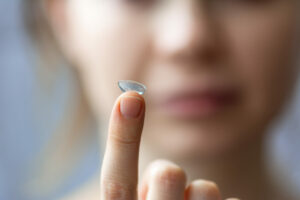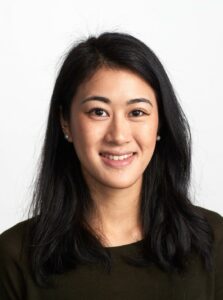November 1, 2023
By Rebecca Dang
Although clinicians can prescribe single-vision contact lenses with the assurance that it will not promote clinically significant myopia progression compared to single-vision spectacles, there are still better options available for myopic children in the form of myopia control interventions.

Conventional correction for myopia in children is to prescribe distance refractive error with single-vision spectacles (SVD). As a patient’s lifestyle needs change, clinicians may offer them the option of switching to soft single-vision contact lenses (SVCL) to improve their quality of life.1 However, an important consideration is whether the switch in refractive correction from SVD to SVCL can detrimentally promote myopia progression.
What Does the Literature Tell Us?
Numerous multiple year studies have found no difference in myopia progression between SVD and SVCL.2–4 A clinical trial compared the myopia progression as measured using dry subjective refraction in a cohort of 175 adolescents aged 11 to 14 years randomized to either SVD or SVCL.2 It found no difference in myopia progression between the two groups after a three-year follow-up period. However, there was a small increase in astigmatism in the SVCL wearing group.
A second study investigated the same question, but now using cycloplegic autorefraction and axial length as primary outcomes.3,5 Myopia progression was compared between children aged 8-11 years, wearing SVD (n=237) and SVCL (n=247) over three years. Again, no statistical difference in myopia progression was found between the two groups for both SER and axial length. A more recent study has also found no significant difference in cycloplegic autorefraction over two years.4
Two studies have identified more myopia progression with SVCL compared to SVD, but only by a minimal, clinically inconsequential amount.6,7 The first short study compared cycloplegic autorefraction in a small sample of 12 children per group, wearing either SVD or soft SVCL, following cessation of a separate clinical trial.6,8 This study found that children wearing soft SVCL had higher refractive progression (-0.747D) compared to SVD (-0.25D) over 12 months. A second larger study found similar results, when comparing SVD (n = 199) or SVCL (n = 87) over 12 months, with the SVCL group progressing -0.52 ± 0.46D compared to SVD -0.25 ± 0.39D, p < 0.0001.7 Similar results were found in a smaller subset of children followed up for 24 months. However, comparisons of axial elongation between the two treatment groups found no difference in myopia progression between the two groups at the 12-month or 24-month follow-up periods.
What Does This Mean for Clinicians?
Studies investigating myopia progression between SVD or SVCL either find no difference in myopia progression or only small, clinically insignificant differences in SER with faster progression with SVCL. In addition, when axial length is compared, no differences were found between SVD or SVCL.5 There is a possibility that the difference found between these studies is due to the different designs and materials of contact lenses investigated, or the difference in follow-up period. Although clinicians can prescribe SVCL with the assurance that it will not promote clinically significant myopia progression compared to SVD, there are still better options available for myopic children in the form of myopia control interventions.10 It is important to assess each patient individually for their risk of myopic sequelae, considering patient factors such as lifestyle and personality, and offer patients effective myopia control options where appropriate.
Conclusion
Current evidence shows no clinically significant difference in axial elongation between myopia progression with SVCL and SVD. However, there are better, more effective myopia management options for juvenile-onset myopes which should be offered where appropriate.
 |
Rebecca Dang is a PhD candidate at UNSW’s School of Optometry and Vision Science, researching therapeutic adherence in multifocal contact lenses for myopia control. She is also an education-focused lecturer at UNSW, where she instructs and supervises students in pediatric clinical optometry and myopia control. Additionally, she serves as an Associate Editor at Clinical Experimental Optometry. |
References
- Walline, J. J. et al. Benefits of Contact Lens Wear for Children and Teens. Eye Contact Lens 33, (2007).
- Horner, D. G., Soni, P. S., Salmon, T. O. & Swartz, T. S. Myopia progression in adolescent wearers of soft contact lenses and spectacles. Optom. Vis. Sci. Off. Publ. Am. Acad. Optom. 76, 474–479 (1999).
- Walline, J. J. et al. A Randomized Trial of the Effect of Soft Contact Lenses on Myopia Progression in Children. Invest. Ophthalmol. Vis. Sci. 49, 4702–4706 (2008).
- Malinowski, A. et al. A Clinical Study of the Impact of Soft Contact Lenses on the Progression of Myopia in Young Patients. Clin. Ophthalmol. Volume 16, 51–62 (2022).
- Wolffsohn, J. S. et al. IMI–Clinical Myopia Control Trials and Instrumentation Report. Invest. Ophthalmol. Vis. Sci. 60, M132–M160 (2019).
- Fulk, G. W., Cyert, L. A., Parker, D. E. & West, R. W. The effect of changing from glasses to soft contact lenses on myopia progression in adolescents. Ophthalmic Physiol. Opt. 23, 71–77 (2003).
- Marsh-Tootle, W. L. et al. Myopia Progression in Children Wearing Spectacles vs. Switching to Contact Lenses. Optom. Vis. Sci. 86, 741 (2009).
- Fulk, G. W., Cyert, L. A. & Parker, D. E. A randomized trial of the effect of single-vision vs. bifocal lenses on myopia progression in children with esophoria. Optom. Vis. Sci. 77, 395–401 (2000).
- Pomeda, A. R. et al. MiSight Assessment Study Spain: A Comparison of Vision-Related Quality-of-Life Measures Between MiSight Contact Lenses and Single-Vision Spectacles. Eye Contact Lens 44, S99–S104 (2018).
- Gifford, K. L. et al. IMI – Clinical Management Guidelines Report. Investig. Opthalmology Vis. Sci. 60, M184 (2019).













